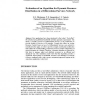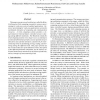ICN
2001
Springer
14 years 3 months ago
2001
Springer
New applications have been introduced to the today’s “best-effort” IP networks having different bandwidth and delay guarantee requirements. The IETF is currently focused on D...
HPCC
2009
Springer
14 years 4 months ago
2009
Springer
—Grid computing has emerged as a way to share geographically and organizationally distributed resources that may belong to different institutions or administrative domains. In th...
GPC
2009
Springer
14 years 4 months ago
2009
Springer
A typical grid application requires several processors for execution that may not be fulfilled by single cluster at times. Co-allocation is the concept of aggregating computing res...
WORDS
2002
IEEE
14 years 4 months ago
2002
IEEE
: The monolithic and inflexible nature of current middleware has made it difficult to deal with emerging technologies such as multimedia. Since these applications have timeliness c...
IPPS
2002
IEEE
14 years 4 months ago
2002
IEEE
Future scalable, high throughput, and high performance applications are likely to execute on platforms constructed by clustering multiple autonomous distributed servers, with reso...
HPDC
2002
IEEE
14 years 4 months ago
2002
IEEE
While distributed, heterogeneous collections of computers (“Grids”) can in principle be used as a computing platform, in practice the problems of first discovering and then co...
HPCS
2002
IEEE
14 years 4 months ago
2002
IEEE
This paper presents a novel architecture called the MetaGrid based on Grid computing concepts for resource provisioning for wide-area network-enabled applications. Resource provis...
ECBS
2002
IEEE
14 years 4 months ago
2002
IEEE
Resource heterogeneity offers a new challenge to portability of resource critical applications such as multimedia or interactive applications. Under heterogeneous environments, a ...
EAGC
2003
Springer
14 years 4 months ago
2003
Springer
: Grids are gaining more importance in this era of Internet technology to maximize the use of resources such as hardware and software infrastructure. The grid provides a platform t...
EAGC
2003
Springer
14 years 4 months ago
2003
Springer
Application layer networks are software architectures that allow the provisioning of services requiring a huge amount of resources by connecting large numbers of individual compute...


